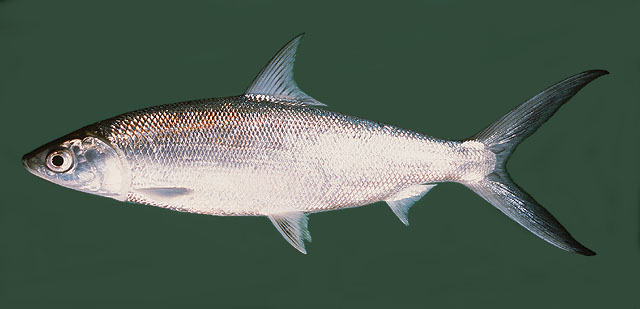| Chanidae (Milkfish) |
| 180 cm SL (male/unsexed); 124 cm SL (female); max.weight: 14 kg; max. reported age: 15 years |
|
benthopelagic; depth range 1 - 30 m, amphidromous |
| Indo-Pacific: along continental shelves and around islands, where temperatures are greater than 20°C. Red Sea and South Africa to Hawaii and the Marquesas, north to Japan, south to Victoria, Australia. Eastern Pacific: San Pedro, California to the Galapagos. |
|
Dorsal spines (total): 2-2; Dorsal soft rays (total): 13-17; Anal spines: 2-2; Anal soft rays: 8-10; Vertebrae: 46-46. This species is characterized by the following: body elongate and somewhat compressed; mouth small and toothless; branchiostegal rays 4; one dorsal fin; pectoral fins falcate; body olive green; flanks silvery; fins dark bordered (Ref. 55763). Superficially resembles bonefishes but by evolution more advanced by having 4 branchiostegal rays (Ref. 1602); jaws toothless (Ref. 12693); with 31 caudal fin rays (Ref. 50686). |
| Found in offshore marine waters and shallow coastal embayments, but also frequently enter estuaries and occasionally penetrate freshwater streams (Ref. 44894). A marine species which enters estuaries and rivers (Ref. 52331). Adults occur in small to large schools near the coasts or around islands where reefs are well developed. Eggs and larvae are pelagic up to 2-3 weeks. Older larvae migrate onshore and settle in coastal wetlands (mangroves, estuaries) during the juvenile stage, or occasionally enter freshwater lakes. Juveniles and sub-adults return to sea where they mature sexually. Spawn only in fully saline water. Larvae eat zooplankton; juveniles and adults eat cyanobacteria, soft algae, small benthic invertebrates, and even pelagic fish eggs and larvae. Larvae are collected from rivers and are grown in culture ponds into juveniles, which are marketed fresh, smoked, canned or frozen. Brood stocks can be raised and spawned in captivity to produce larvae in the hatchery (Ref. 12868). Can thrive and grow in water as hot as 32° C (Ref. 9987). |
|
Not Evaluated
(Ref. 96402)
|
| harmless |
|
Source and more info: www.fishbase.org. For personal, classroom, and other internal use only. Not for publication.
Page created by Jen, 05.08.02,
php script by kbanasihan 06/09/2010 ,
last modified by
dsantos, 20/08/10

